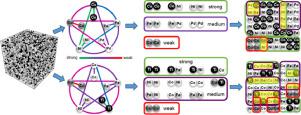Acta Materialia ( IF 8.3 ) Pub Date : 2021-01-17 , DOI: 10.1016/j.actamat.2021.116638 Shuai Chen , Zachary H. Aitken , Subrahmanyam Pattamatta , Zhaoxuan Wu , Zhi Gen Yu , Rajarshi Banerjee , David J. Srolovitz , Peter K. Liaw , Yong-Wei Zhang

|
Recently, atomic segregation, short-range ordering, and cluster formation have been observed experimentally in high-entropy alloys (HEAs). Differences in the atomic size and electronegativity of constituent elements were proposed to be the underlying cause of such ordering. Here, we investigated two HEAs, CoCuFeNiPd and CoCuFeNiTi, using a combination of Monte Carlo and molecular dynamic simulations. Our results show that the CoCuFeNiPd HEA exhibits much stronger atomic segregation and short-range ordering than the CoCuFeNiTi HEA, despite the larger differences in the relative atomic size and electronegativity of Ti with other constituent elements, as compared to those of Pd, suggesting that the differences in the atomic size and electronegativity alone are insufficient to explain the simulation results. We find that it is the chemical-affinity disparity and exclusivity between Ti (Pd) with the remaining species that lead to the different clustering behavior in these two HEAs. Specifically, three conditions for strong atomic segregation and short-range ordering are identified: 1. a large chemical-affinity disparity amongst the chemical elements; 2. a high chemical-element exclusivity in low-, medium-, and high-energy clusters; and 3. a net energy reduction associated with low- and medium-energy-cluster formation that compensates for the energy increase associated with high-energy-cluster formation. Our findings are in agreement with experimental results reported in literature, and highlight the importance of chemical-affinity disparity and exclusivity in influencing the microstructure of HEAs, explain the origin of high-energy-cluster formation in HEAs, and provide guidelines for designing HEAs with excellent properties.
中文翻译:

化学亲和力差异和排他性驱动原子偏析,短程有序和高熵合金中的团簇形成
最近,在高熵合金(HEA)中实验观察到原子偏析,短程有序和团簇形成。提出了构成元素的原子尺寸和电负性方面的差异是这种排序的根本原因。在这里,我们结合蒙特卡罗和分子动力学模拟研究了两种HEA,CoCuFeNiPd和CoCuFeNiTi。我们的研究结果表明,尽管与Pd相比,Ti与其他构成元素的相对原子尺寸和电负性差异较大,但CoCuFeNiPd HEA表现出比CoCuFeNiTi HEA更强的原子偏析和短程有序性。仅原子尺寸和电负性方面的差异不足以解释模拟结果。我们发现,正是Ti(Pd)与其余物种之间的化学亲和力差异和排他性导致了这两种HEA中不同的聚集行为。具体来说,确定了用于强原子偏析和短程有序的三个条件:1.化学元素之间存在较大的化学亲和力差异;2.在低,中和高能簇中具有高化学元素排他性;3.与中低能量集群形成相关的净能量减少,以补偿与高能量集群形成相关的能量增加。我们的发现与文献报道的实验结果相符,并强调了化学亲和力差异和排他性在影响HEA微观结构方面的重要性,











































 京公网安备 11010802027423号
京公网安备 11010802027423号